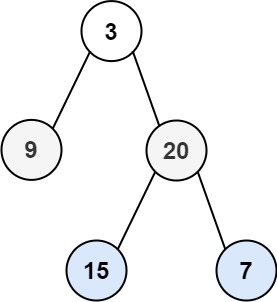目录
题目描述:
代码:
第一种:
第二种:
TreeNode:
LinkedListNode:
题目描述:
给你二叉树的根节点 root ,返回其节点值的 层序遍历 。 (即逐层地,从左到右访问所有节点)。
示例 1:

输入:root = [3,9,20,null,null,15,7] 输出:[[3],[9,20],[15,7]]
示例 2:
输入:root = [1] 输出:[[1]]
示例 3:
输入:root = [] 输出:[]
代码:
第一种:
LinkedListQueue<TreeNode> queue = new LinkedListQueue<TreeNode>();
queue.offer(root);
int c1=1;//当前的节点数
while(!queue.isEmpty()){
int c2=0;
for(int i=0;i<c1;i++){
TreeNode n=queue.poll();
System.out.print(n+" ");
if(n.left!=null){
queue.offer(n.left);
c2++;
}
if(n.right!=null){
queue.offer(n.right);
c2++;
}
}
System.out.println();
c1=c2;
}第二种:
public List<List<Integer>> levelOrder(TreeNode root) {
List<List<Integer> > res = new ArrayList<>();
if(root==null) return res;
LinkedListQueue<TreeNode> queue = new LinkedListQueue<TreeNode>();
queue.offer(root);
int c1=1;//当前的节点数
while(!queue.isEmpty()){
List<Integer> level=new ArrayList<>();
int c2=0;
for(int i=0;i<c1;i++){
TreeNode n=queue.poll();
level.add(n.val);
if(n.left!=null){
queue.offer(n.left);
c2++;
}
if(n.right!=null){
queue.offer(n.right);
c2++;
}
}
res.add(level);
c1=c2;
}
return res;
}TreeNode:
package TreeNode;
public class TreeNode {
public int val;
public TreeNode left;
public TreeNode right;
public TreeNode(int val)
{
this.val = val;
}
public TreeNode( TreeNode left,int val, TreeNode right){
this.val = val;
this.left = left;
this.right = right;
}
public String toString(){
return String.valueOf(val);
}
}
LinkedListNode:
public class LinkedListQueue <E> implements Queue<E>, Iterable<E>{//单向环形哨兵链表
//节点类
private static class Node<E>{
E value;
Node<E> next;
Node(E value, Node<E> next){
this.value=value;
this.next=next;
}
}
Node<E> head=new Node<>(null,null);
Node<E> tail=head;//tail指向头
private int size=0;//节点数
private int capacity=Integer.MIN_VALUE;//容量
public LinkedListQueue(){
tail.next=head;
}
public LinkedListQueue(int capacity){
this.capacity=capacity;
tail.next=head;
}
//从队尾插入
@Override
public boolean offer(E value) {
if(isFull()){
return false;
}
Node<E> added= new Node<>(value,head);//added新节点尾部指向头
tail.next=added;//原来的尾部指向新节点
tail=added;//尾部指向新节点
size++;
return true;
}
//获取队列的第一个值,并移除
@Override
public E poll() {
if(isEmpty()){
return null;
}
E value=head.next.value;
Node<E> first=head.next;
head.next=first.next;
size--;
if(first==tail){
tail=head;
}
return value;
}
//从对头获取值,但不移除
@Override
public E peek() {
if(isEmpty()){
return null;
}
return head.next.value;
}
@Override
public boolean isEmpty() {
return head==tail;
}
@Override
public boolean isFull() {
return size==capacity;
}
@Override
public Iterator<E> iterator() {
return new Iterator<E>(){
Node<E> p=head.next;
public boolean hasNext() {//p==head退出
return p!=head;
}
public E next(){
E value=p.value;
p=p.next;
return value;
}
};
}
}


















